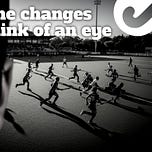In the world of competitive sports, "focus" is a word constantly thrown around. Athletes are urged to "stay focused," "focus up," or "keep their eye on the ball." But what does focus truly mean from a neurological perspective, and how can coaches equip their players – and themselves – with concrete tools to enhance this crucial skill? Recent scientific insights, particularly from the study of attention and the brain's visual systems, offer powerful, actionable strategies that go far beyond mere pep talks.
Let’s delve into two fascinating areas of research: the concept of "attentional blinks" and the intricate relationship between blinking, dopamine, and our perception of time. By understanding these mechanisms, field hockey coaches can unlock new ways to train attention, reduce errors, and ultimately, improve performance on the field.
The Silent Gaps: Understanding Attentional Blinks and Why They Matter in Sports
Imagine the chaos of a busy game: players moving, the ball in flight, opponents converging, fans roaring. An athlete's brain (and you as a coach) is constantly bombarded with sensory information. Our attention, however, is selective. We perceive only a fraction of what our senses take in, focusing on what's most relevant. But even when we're trying our hardest to concentrate, there's a peculiar phenomenon at play called an "attentional blink".
Think of it like a "Where's Waldo?" puzzle. When you’re intently searching for Waldo amidst a busy scene and you finally spot him, your nervous system experiences a momentary, albeit subtle, "celebration" through the release of neurochemicals. This brief pause, this "mild celebration," causes your attention to blink or temporarily shut off for a second.
Crucially, during this "blink," you are unable to perceive other information, even if it's right next to what you just identified.
In a field hockey context, this has profound implications. Your player might be intensely focused on the ball, only to miss a teammate making a critical run, an opponent's subtle shift, or a sudden change in the game's tempo. Their attention didn't wander; it "blinked" because it successfully registered one piece of information, temporarily blinding them to another immediately following.
Interestingly, research suggests that individuals with ADHD (Attention Deficit Hyperactivity Disorder) may experience more attentional blinks than those without the condition. This is a crucial insight: it’s not necessarily that people with ADHD can't focus – in fact, they can exhibit "hyperfocus" on tasks they genuinely enjoy or are intrigued by. Their challenge often lies in sustaining that attention for mundane tasks or in efficiently transitioning their focus without these "blinks".
For coaches, this means that some players might naturally be more prone to these fleeting moments of inattention, impacting their consistency on the field.
Expanding the Field: Harnessing "Open Monitoring" and "Panoramic Vision"
Fortunately, our visual system offers a powerful antidote to attentional blinks. It operates in two primary modes:
1. "Soda Straw View": This is our highly focused, narrow gaze, perfect for pinpointing a single target.
2. "Panoramic Vision": This is a dilated, wide-angle view, mediated by a separate neural circuit in the brain. This circuit isn't just about seeing widely; it's also superior at processing information in time, operating with a higher "frame rate".
The state of "open monitoring" can be accessed through panoramic vision, allowing individuals to attend to and recognize multiple targets simultaneously. For athletes, this translates directly to enhanced situational awareness: seeing the entire field, tracking multiple players, anticipating plays, and perceiving passing lanes or defensive weaknesses that a "soda straw" focus might miss.
The "Open Monitoring" Tool for Coaches and Players: Remarkably, studies have shown that even a single 17-minute session of consciously practicing gaze dilation (entering open gaze) and then contracting it significantly reduces the number of attentional blinks. This improvement in focus can be near-permanent, without any additional training. This is a game-changer, applicable to anyone, regardless of whether they have ADHD.
Coaches can integrate this practice:
Warm-up Drill: Before practice or a game, guide players through a brief exercise. Have them consciously dilate their gaze to take in the entire visual environment – the whole field, the stands, the sky – without focusing on any one thing. Then, instruct them to slowly contract their field of view, narrowing their focus to a specific object, like their hand, then a distant goalpost, and back out again.
Situational Awareness Training: Encourage players to practice maintaining a panoramic view during drills, consciously trying to observe multiple teammates, opponents, and the ball, rather than fixating on just one element.
By intentionally training this capacity, coaches can help players develop a more adaptable and comprehensive visual attention, reducing those critical "blinks" that can lead to missed opportunities or defensive lapses.
The Hidden Clock: Blinking, Dopamine, and Time Perception in Sports
Beyond just what we see, how we see it, and when we blink, profoundly influences our perception of time. Believe it or not, our perception of time resets right after we blink. This seemingly simple act of blinking, which we do subconsciously thousands of times a day, is intricately linked to our internal clock.
What controls our blinking rate?








